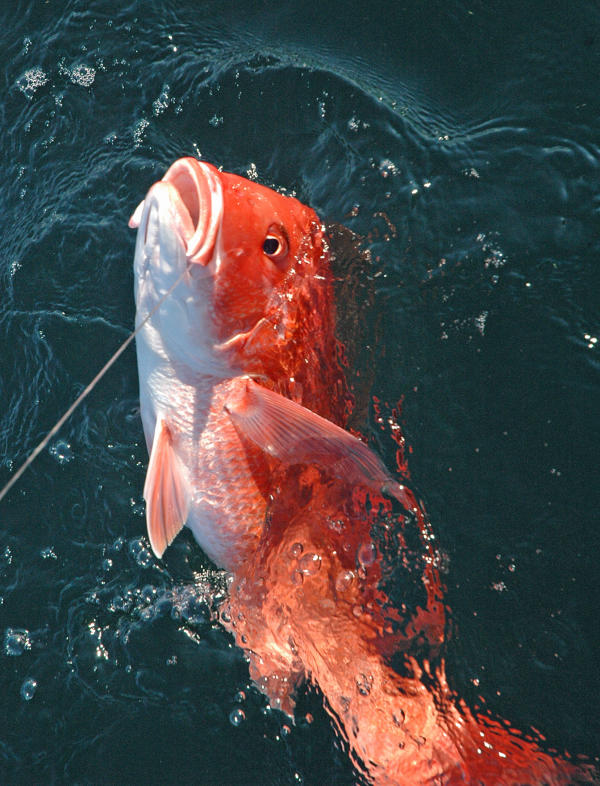
|
The following was released by the South Atlantic Fishery Management Council:
Recreational fishermen gearing up for the upcoming red snapper mini-season are reminded that the weekend openings provide more than just an opportunity to land a nice red snapper for dinner. The season also provides an important window for data collection crucial to red snapper management and fishermen can help in a number of ways. The recreational fishery will open for two consecutive 3-day weekends: August 10-12, 2018 and August 17-19, 2018 with a 1 fish per person per day bag limit and no minimum size limit. The commercial fishery is currently open with a 75 pound (gutted weight) trip limit, no minimum size limit, and will close when the commercial annual catch limit of 124,815 pounds whole weight (12,854 fish) is met or by December 31, 2018. The recreational annual catch limit is 42,510 fish.
During the opening, state marine resource agencies along with NOAA Fisheries will have personnel stationed along the coasts of North Carolina, South Carolina, Georgia and the east coast of Florida to gather information from fishermen as they return from their fishing trips. In addition to cooperating with these efforts, recreational fishermen can also take the initiative to report their fishing activities via a mobile app as they occur offshore and keep a personal log for future reference.
Recreational anglers now have the opportunity to report and log information about their recreational trips and catches through the MyFishCount electronic reporting mobile app. The app is available for free download at the Google Play and App Store, or through the MyFishCount website at www.myfishcount.com. In addition to providing information to fishery scientists and managers, anglers have the ability to access information about their previous trips and catches.
The MyFishCount app is easy to use and instructional videos are available via YouTube. To learn more, visit https://www.myfishcount.com or http://safmc.net/electronic-reporting-projects/myfishcount/.
The MyFishCount project was developed by the South Atlantic Fishery Management Council in conjunction with Angler Action (Snook and Gamefish Foundation) and Elemental Methods with funding from NOAA Fisheries. The project is designed to help provide information not previously captured in current monitoring programs. Once a personal MyFishCount account is established, fishermen may report information about their fishing activities, including species kept and released, the length and number of fish released, catch location, depth fished, gear used, release treatment, reason for release and more. Anglers can also report trips that had to be abandoned due to poor weather conditions, which was an important data point collected in the 2017 red snapper mini-season that contributed to the decision to allow for additional fishing days.
MyFishCount participants are able to record their fishing trips throughout the year, regardless of the species targeted or location fished, and will have access to their stored information. The 2018 red snapper mini-season offers an excellent opportunity for recreational fishermen to open an account and participate in the new pilot project.
Fishermen heading back to boat ramps and marinas during the red snapper mini-season are encouraged to assist state marine resource agency staff and NOAA Fisheries personnel with expanded efforts to collect information, even if the MyFishCount app has been used offshore. Pausing to provide answers to a few questions or allowing staff to quickly take biological samples such as otoliths (ear bones) from red snapper catches will provide valuable data that may be used in future stock assessments and management decisions. Carcass collection sites with freezers and catch cards for recording information about the fish will also be established by some states.
In addition, law enforcement personnel will have a higher presence on the water. Safety will be a primary focus for enforcement officers as fishermen head offshore, along with ensuring regulations are being followed.
It may seem simple, but good angler ethics and best practices will go a long way in making a good fishing trip a great one. Know the rules. For example, the use of non-stainless steel circle hooks is required when targeting snapper grouper species (including red snapper) when fishing with natural baits in waters North of 28 degrees latitude (a line just south of Melbourne, Florida). Dehooking devices are also required onboard.
Plan ahead and have the equipment needed to properly release a fish. Know how to properly handle a fish and if snapping a photo of your catch, be ready with your camera before the fish comes onboard. Catch and release is okay, but move off of an area to avoid releasing too many fish. To help you plan ahead and prepare for a successful trip, check out the list of Best Fishing Practices and other information now available from the Council’s website at: http://safmc.net/2018-red-snapper-season/. The website also includes additional details on data collection efforts by state marine resources agencies during the 2018 red snapper season, including carcass collection sites.
The Council is currently considering options for requiring best fishing practices to reduce the number of released fish and release mortality for species in the snapper grouper management complex. Public scoping webinars are scheduled for August 7th and 8th, and written public comment is being accepted until August 17, 2018. Learn more at: http://safmc.net/safmc-meetings/public-hearings-scoping-meetings/.